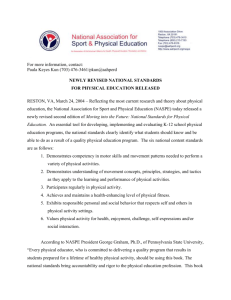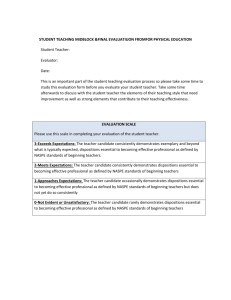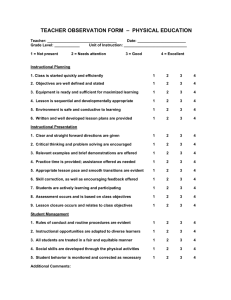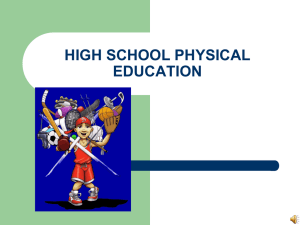Document 15606785
advertisement
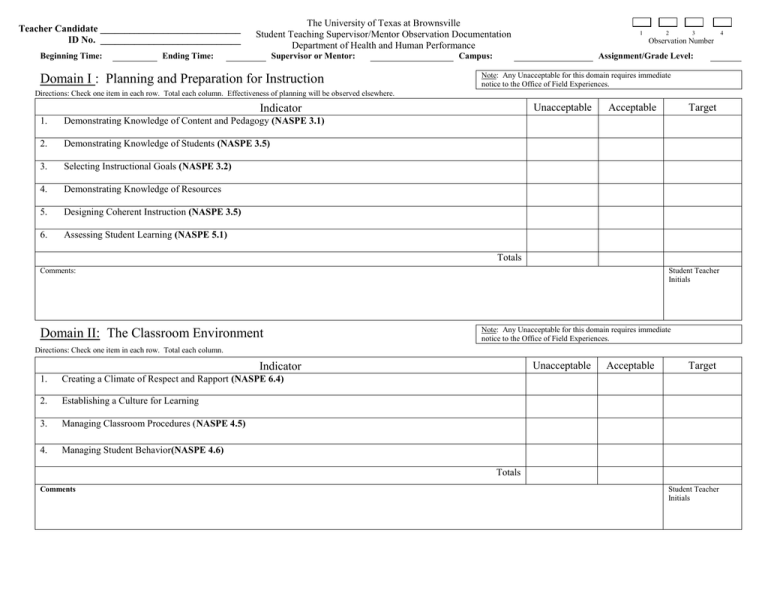
Teacher Candidate _____________________________ ID No. _____________________________ Beginning Time: The University of Texas at Brownsville Student Teaching Supervisor/Mentor Observation Documentation Department of Health and Human Performance Ending Time: Supervisor or Mentor: Domain I : Planning and Preparation for Instruction 1 2 3 Observation Number Campus: Assignment/Grade Level: Note: Any Unacceptable for this domain requires immediate notice to the Office of Field Experiences. Directions: Check one item in each row. Total each column. Effectiveness of planning will be observed elsewhere. Unacceptable Indicator 1. Demonstrating Knowledge of Content and Pedagogy (NASPE 3.1) 2. Demonstrating Knowledge of Students (NASPE 3.5) 3. Selecting Instructional Goals (NASPE 3.2) 4. Demonstrating Knowledge of Resources 5. Designing Coherent Instruction (NASPE 3.5) 6. Assessing Student Learning (NASPE 5.1) Acceptable Target Totals Comments: Student Teacher Initials Domain II: The Classroom Environment Note: Any Unacceptable for this domain requires immediate notice to the Office of Field Experiences. Directions: Check one item in each row. Total each column. Unacceptable Indicator 1. Creating a Climate of Respect and Rapport (NASPE 6.4) 2. Establishing a Culture for Learning 3. Managing Classroom Procedures (NASPE 4.5) 4. Managing Student Behavior(NASPE 4.6) Acceptable Target Totals Comments Student Teacher Initials 4 Teacher Candidate _____________________________ ID No. _____________________________ The University of Texas at Brownsville Student Teaching Supervisor/Mentor Observation Documentation Department of Health and Human Performance 1 2 3 Observation Number Note: Any Unacceptable for this domain requires immediate notice to the Office of Field Experiences. Domain III: Instruction Directions: Check one item in each row. Total each column. Unacceptable Indicator 1. Communicating Clearly and Accurately(NASPE 4.1) 2. Using Questioning and Discussion Techniques 3. Engaging and Motivating Students to Learn (NASPE 3.3) 4. Demonstrating Flexibility and Responsiveness (NASPE 4.4) 5. Academic Progress of Student Learning is monitored and assessed (NASPE 5.2) Acceptable Target Totals Student Teacher Initials Comments: Domain IV: Professional Responsibilities Note: An Unacceptable for this domain requires immediate notice to the Office of Field Experiences. Directions: Check one item in each row. Total each column. Indicator 1. Unacceptable Acceptable Target Reflecting on Teaching (NASPE 5.3) Comments: Student Teacher Initials Indicators 2 – 5: Communicating with Families, Maintaining Accurate Records, Growing and Developing Professionally and Contributing to School and Community are often not directly observable during instruction and are cumulative in nature. Therefore these Domain IV indicators will be reviewed and evaluated during the two ThreeWay Conferences held during the Student Teaching experience. 4 Teacher Candidate _____________________________ ID No. _____________________________ The University of Texas at Brownsville Student Teaching Supervisor/Mentor Observation Documentation Department of Health and Human Performance 1 2 3 Observation Number NCATE/NASPE ADDENDUM Directions: Check one item in each row. Total each column. 1. 2. 3. 4. 5. 6. 7. 8. 9. 10. 11. 12. 13. 14. 15. 16. • • Indicator Learning tasks are based on a proper physiological and biomechanical concepts. (NASPE 1.1) Students remain on-task and engaged in the learning/practice tasks. (NASPE 1.2) Learning tasks are developmentally appropriate. (NASPE 1.3) Identifies and corrects critical elements of motor skills and performance concepts. (NASPE 1.5) Designs and implements both short (daily lesson plans) and long (unit plans) that are linked to state/national standards. (NASPE 3.1) Effectively manages available resources provide active, fair, and equitable learning experiences.(NASPE 3.4) Plans appropriate and logically sequenced instructional strategies. (NASPE 3.6) Integrates technology**appropriately into teaching and learning. (NASPE 3.7) Unacceptable Acceptable Target Develops and uses appropriate demonstrations and explanations that aid student learning. ( NASPE 4.2) Develops and uses appropriate instructional cues. (NASPE 4.2) Analyze skills and performance concepts and provides specific corrective feedback. (NASPE 4.3) Strategies promote social responsibility.(NASPE 4.6) Plans for appropriate assessment, analysis of results, and maintenance of records. (NASPE 5.1) Establishes, communicates, and maintains high expectations for student achievement and participation. Students are given opportunities and support to assume responsibility for their own learning. (NASPE 6.1) Presents self in a professional manner in terms of appearance, attitude, attire, and conduct. (NASPE 6.3) Communicates in ways that demonstrate sensitivity to all students.(NASPE 6.4) Diversity refers to “differences among groups of people and individuals based n ethnicity, race, socioeconomic status, gender, exceptionalities, language, religion, sexual orientation, and geographic area.” (NCATE Professional Standards, 2002, p.53) Examples of appropriate application of technology include: P-12 students using multimedia software to create presentations; P-12 students using spreadsheet/graphing software to analyze data; P-12 students using digital video to tell a story; P-12 students with special needs/ESOL using assistive technology to meet curricular objectives. Using a word processor to type lesson plans, showing a video or using the overhead projector, or intern e-mail communication are not considered adequate use of technology for this indicator. __________________________________________ Date: __________ Student Teacher’s signature ____________________________ Supervisor’s/Mentor’s signature __________________________________________ Date:________________ School Administrator’s/Receiving Party signature Date: _________________ 4 Assessment Rubric Domain I : Planning and Preparation for Instruction Indicator Unacceptable Acceptable Target 1. Demonstrating Knowledge of Content and Pedagogy (NASPE 3.1) Teacher’s display of lack of understanding of subject, structure of discipline, content-related pedagogy will result in student misconceptions of content, teacher’s inappropriate selection of materials, activities, delivery of instruction. Teacher’s knowledge of content and pedagogy are Acceptable . Plan did not effectively prepare for delivery of instruction, activities, materials that will ensure understanding of content by all students (including SPED, ELL). Teacher’s understanding of content and pedagogy allows for planned delivery of instruction, learning activities, directly tied to content and will facilitate understanding of all (inc. SPED and ELL) students. 2. Demonstrating Knowledge of Students (NASPE 3.5) Teacher makes little or no attempt to acquire /does not have knowledge of students’ backgrounds, skills, and/or interests, and, therefore, cannot use such knowledge in planning. TC makes inappropriate accommodations and/or modifications for students exceptionalities. Teacher demonstrates partial knowledge of students’ backgrounds, skills, interests, and functional levels and uses this knowledge to plan for delivery of instruction (includes group and individual work.). TC adds accommodations and/or modifications for students exceptionalities. Teacher demonstrates thorough knowledge of individual students’ backgrounds, skills, interests, and functional levels and uses this knowledge to plan for delivery of instruction (includes group and individual work). TC adds specific accommodations and/or modifications for students exceptionalities. 3. Selecting Instructional Goals (NASPE 3.2) Teacher’s planned goals/objectives not curriculum related or represent little or no educational value, are unsuitable for students or do not show consideration of individual student functional levels and offer little or no opportunities for assessment. Teacher’s planned goals /objectives somewhat tied to curriculum, state standards and TAKS and educational/functional levels of most students. Teacher’s planned goals and objectives represent valuable learning, are suitable for all (inc. SPED, ELL) students in the class; Goals/objectives reflect opportunities for integration and permit viable methods of assessment directly tied to curriculum, state standards (TEKS)/ assessments. 4. Demonstrating Knowledge of Resources Teacher is unaware of school or district resources available including technology such as computers, Smart Boards and other items, either for teacher or for student use, therefore not including them in instructional plan. Teacher displays some knowledge of school or district resources available including technology such as computers and Smart Boards for teacher or students but does not plan for their effective use. Teacher is fully aware of school and district resources available for teaching, including items such as computers and Smart Boards, and plans for their use, when appropriate, during instruction. 5. Designing Coherent Instruction (NASPE 3.3) The planned activities and materials do not support stated instructional goals/obj., engage students in meaningful learning, and the lesson does not flow from focus/introduction to conclusion /closing. Some of the elements of the instructional plan support the stated instructional goals/obj. and the key knowledge/skills while others do not. The plan does not have an obvious structure/lacks critical components. Planning includes variety of activities and materials that support goals/objectives and skills and allows time for meaningful engagement and interaction by all (inc. SPED and ELL)students. Plan is clearly structured and includes closure that can be observed. 6. Assessing Student Learning (NASPE 5.1) Teacher’s planned approach to assessing student learning contains no clear criteria or standards, and lacks congruence with the instructional goals./obj. Teacher has no plan to use assessment results. Teacher’s plan for student assessment is partially aligned with the instructional goals/obj. but includes some criteria and standards that are not related and/or clearly stated and plans for assessing all (inc. SPED and ELL) students not defined. Teacher’s plan for student assesssment of goals/objective is clearly stated/delineated and assessment is directly related to content , includes .methods to assess all students (including SPED and ELL). Domain II: The Classroom Environment Indicator Unacceptable Acceptable Target 1. Creating a Climate of Respect and Rapport (NASPE 6.4) Classroom interactions, both between the teacher and students and among students, are negative or inappropriate and characterized by sarcasm, putdowns, or conflict. Classroom interactions are generally appropriate and free from conflict but may be characterized by occasional display of insensitivity. Students treated with dignity and respect is mutual. Teacher aware of student cultural and developmental differences and makes an effort to ensure students feel valued and respected. Verbal and non-verbal behaviors by teacher and among students reflect respect, warmth and caring. 2. Establishing a Culture for Learning The classroom does not represent a culture for learning and is characterized by low teacher commitment to the subject, low expectations for student achievement, and student pride in work is not evident. The classroom environment reflects only a minimal culture for learning with only modest or inconsistent expectations for student achievement, minimal teacher commitment to the subject, and minimal student pride in work. Both teacher and students are performing at the minimal level. The classroom environment represents a genuine culture for learning with commitment to the subject on the part of both the teacher and students, high expectations for student achievement, and student pride in work. 3. Managing Classroom Procedures (NASPE 4.5) Classroom routines and procedures are either nonexistent or not effective, resulting in the major loss of valuable instructional/learning time. Classroom routines and procedures have beeen established but function unevenly or inconsistently, with some loss of valuable instructional/learning time. 4. Managing Student Behavior (NASPE 4.6) Student behavior is not appropriate. The teacher does not establish clear behavioral expectations, and/or monitor student behavior, and does not respond to or gives inappropriate response to student misbehavior. Teacher makes an effort to establish standards of conduct for students, monitor student behavior and respond to student misbehavior, but his/her efforts are not always successful. Classroom routines and procedures have been established and function smoothly for the most part, with little or no loss of valuable instructional/learning Time. Utilizes managerial rules, routines, and transitions to create and maintain a safe and effective learning environment. Teacher is aware of student behavior, has established clear standards of conduct, and responds to students’ misbehavior in ways that are appropriate, effective and respectful of the students. Domain III: Instruction Indicator Unacceptable Acceptable Target 1. Communicating Clearly and Accurately (NASPE 4.1) Teacher’s communication contains errors or is unclear, or inappropriate to students. Teacher candidates’s oral, written, and non-verbal communication are error-free but may not be completely appropriate or may require further explanations to avoid confusion by students. Teacher candidate communicates clearly and accurately to students, both orally and in writing and demonstrates effective verbal and non-verbal skills in a variety of settings 2. Using Questioning and Discussion Techniques Teacher makes poor use of questioning and discussion techniques, with low-level questions, limited student participation, and little true discussion. Teacher’s use of questioning and discussion techniques is uneven, with some high–level questions, attempts at true discussion, and moderate student participation. Teacher’s use of questioning and discussion techniques reflects high-level questions, true discussion, and full /appropriate participation by all students. 3. Engaging and Motivating Students to Learn (NASPE 3.3) 4. Demonstrating Flexibility and Responsiveness (NASPE 4.4) Students are not intellectually engaged in significant learning as a result of inappropriate activities or materials, poor representations of content, or lack of lesson structure. With no alignment to lesson objectives Teacher adheres to the instruction plan in spite of evidence of poor student understanding or lack of interest and fails to respond to students’ questions. Teacher assumes no obvious responsibility for students’ failure to understand and does not attempt to remedy the situation. Students are only partially engaged intellectually as a result of activities or materials of uneven quality, inconsistent representations of content, or uneven structure or pacing of the lesson with inconsistent alignment to lesson objectives Teacher candidate recognizes the changing dynamics of the environment and demonstrates moderate flexibility and responsiveness to students’ needs and interests during a lesson and attempts to ensure the success of all students. Students are intellectually engaged & motivated throughout the lesson, with appropriate activities and materials, correct/appropriate representations of content and suitable structure and pacing of the lesson which are aligned with lesson objectives. Teacher candidate recognizes the changing dynamics of the environment and seeks ways to ensure successful learning for all students, making adjustments, as needed, to instructional plans and responds effectively and appropriately to student interests and questions. 5. Academic Progress of Student Learning is monitored and assessed (NASPE 5.2) Teacher does not monitor student work and does not provide formative assessment prior to independent practice. Teacher does not often monitor student work and often does not provide formative assessment prior to independent practice. Teacher often monitors student work and often provides formative assessment prior to independent practice. Domain IV: Professional Responsibilities 1. Indicator Unacceptable Acceptable Target Reflecting on Teaching (NASPE 5.3) Teacher does not reflect accurately on the lesson or proposes ideas as to how it might be improved. Teacher’s reflection on the lesson is generally accurate, and teacher makes global suggestions as to how it might be improved. Teacher reflects accurately on the lesson, citing general characteristics and makes some specific suggestions about how it might be improved. NCATE/NASPE ADDENDUM Indicator 1. 2. 3. Learning tasks are based on a proper physiological and biomechanical concepts. (NASPE 1.1) Students remain ontask and engaged in the learning/practice tasks. (NASPE 1.2) Learning tasks are developmentally appropriate. (NASPE 1.3) Unacceptable Acceptable Target TC does not properly apply physiological and/or biomechanical concepts into the practice tasks. Progressions are not sequential or do not provide students with tasks which increase or decrease the task complexity. TC does not provide sufficient practice tasks which allow students to begin and end at different levels based on individual differences Students are off-tasks and modifying practice tasks inappropriately. Students are off-task due to the inappropriate level of difficulty of tasks (either too easy or too hard), steps in skill progressions are out of sequence, or task complexity is inappropriate. Learning tasks are inappropriate for the developmental level of students by being either too difficult or too easy and do not use appropriate motor development theory and practices. Students are off-task due to the inappropriate level of difficulty of tasks. TC fails to make adjustments to tasks to accommodate students’ developmental levels by increasing or decreasing task complexity. TC incorporates minimal physiological and/or biomechanical concepts into the practice tasks which lead to student learning. Progressions are sequential and progressive with opportunities for students to extend tasks to increase or decrease the task complexity. TC provides learning/practice tasks which allow students to begin and end at different levels based on individual readiness. TC incorporates minimal motor learning and behavioral theory concepts into the practice tasks which lead to student learning. Progressions are sequential and progressive with opportunities for students to extend tasks to increase or decrease the task complexity. TC incorporates appropriate physiological and biomechanical concepts into the practice tasks which lead to student learning. Progressions are sequential and progressive with opportunities for students to extend tasks to increase or decrease the task complexity. TC provides learning/practice tasks which allow students to begin and end at different levels based on individual readiness. TC incorporates appropriate motor learning and behavioral theory concepts into the practice tasks which lead to student learning. Progressions are sequential and progressive with opportunities for students to extend tasks to increase or decrease the task complexity. Learning tasks are appropriate for the developmental levels of students by providing appropriate challenges for students using appropriate motor development theory and practices (task are neither too easy nor too difficult for students). Students remain on-task and engaged in the practice task. TC makes some adjustments to tasks to accommodate students’ developmental levels, but adjustments are across the entire class and not individualized. Learning objectives and tasks are appropriate for the developmental level of students by providing appropriate challenges for students using appropriate motor development theory and practices (tasks are neither too easy nor too difficult for students). Students remain on-task and engaged in the practice task. TC makes adjustments to tasks based on student performance (increasing or decreasing tasks complexity based on student performance). Adjustments are both across the entire class and individualized. 4. Identifies critical elements of motor skills and performance concepts. (NASPE 1.5) TC fails to identify key elements of the skill/performance concept during the explanation. TC fails to develop or use appropriate instructional cues or prompts. Students are not provided feedback on critical elements of skills or performance concepts. Daily lesson plans are incomplete and lack specificity. TC does not identify specific unit goals. Lesson plans are incongruent with unit goals. Unit plan is incomplete and does not meet unit plan requirements. Unit plans are not based on pre-assessments of students or development levels of students. Lesson objectives and unit goals have no relationship to state/national standards. Instructional resources are not used effectively throughout the lesson with students not having equal and/or accommodated access to all components. TC identifies key elements of the skill/performance concept during the explanation. Instructional cues and prompts are directly linked to the identified critical elements. Feedback is congruent to the identified key elements. TC identifies key elements of the skill/performance concepts and is innovative in the creation of instructional cues and prompts. TC consistently provides students with specific, corrective feedback based on the identified key elements. 5. Designs and implements both short (daily lesson plans) and long (unit plans) that are linked to state/national standards. (NASPE 3.1) Daily lesson plans meet all lesson plan requirements and are congruent with unit plan goals. Unit plan meets all unit plan requirements. Unit plan goals are based on preassessments and developmental levels of students. Both lesson and unit plans are directly or indirectly aligned with state/national standards. Daily lesson plans meet all lesson plan requirements exceed expectation in specificity and planning detail. Unit plan meets all unit plan requirement and exceed expectation in specificity and identification of key elements. Lesson and unit plans are based on pre and ongoing assessment and developmental levels of students. Both lesson and unit plans are directly aligned with state/national standards. 6. Effectively manages available resources provide active, fair, and equitable learning experiences. (NASPE 3.4) A variety of instructional resources are used throughout the lesson with students having equal and/or accommodated access to all components. Instructional resources are used effectively throughout the lesson with students having equal and/or accommodated access to all components. 7. Plans appropriate and logically sequenced instructional strategies. (NASPE 3.6) Instructional strategies are incongruent with objectives. Some strategies are developmentally inappropriate. The sequence of the lesson may be illogical, with gaps in progressions. Learning/practice tasks are arranged randomly in the lesson with steps between progressions either too large or too small to facilitate skill mastery. TC fails to plan learning experiences based on preassessment data. Most instructional strategies are congruent with objectives. The sequence of the lesson(s) is logical, with few gaps in progressions. Learning/practice tasks are arranged in sequential and progressive steps to facilitate learning. TC plans and implements learning experiences based on pre-assessment data. Integrates technology**appropriately into teaching and learning. (NASPE 3.7) TC does not integrate learning experiences that involve students in the use of technology in a physical activity setting. Technology use in the classroom is limited to the TC. TC demonstrates limited knowledge of current technology and their applications in a physical activity setting. TC integrates learning experiences that involve students in the use of technology in a physical activity such as heart monitors, pedometers, etc. TC Demonstrates knowledge and use of current technology and applies this knowledge in the development and implementation of lessons in a physical activity setting. Instructional strategies are consistently congruent with objectives. All strategies are Developmentally appropriate and address a variety of student needs. The sequence of the lesson is logical with no gaps in progressions. .Learning/practice tasks allow students to begin and end at different levels based on individual readiness. Progressions are sequential and progressive with opportunities for students to extend tasks to increase or decrease the challenge. TC plans and implements learning experiences based on pre-assessment data. TC integrates learning experiences that require students to use various technologies (heart monitors, pedometers, etc.) in a physical activity setting. TC demonstrates mastery of current technologies and uses the technology to enhance student learning. 8. 9. Develops and uses appropriate demonstrations and explanations that aid student learning. ( NASPE 4.2) TC incorrectly demonstrates the skill and does not identify critical elements of the skill. Explanations are either too long or too short for the developmental levels of students. Demonstrations or explanations are given only once during the lesson. TC correctly demonstrates the skill or has a student demonstrate the skill. TC identifies key elements of the skill during the demonstration and tells students where to look during the demonstration. Explanations are brief and appropriate for the developmental levels of students. Demonstrations and explanations are repeated at least twice during the class period. 10. Develops and uses appropriate instructional cues. (NASPE 4.2) 11. Analyze skills and performance concepts and provides specific corrective feedback. (NASPE 4.3) TC creates instructional cues or prompts that identify key elements of the skill/strategies. Number of instructional cues/prompts is appropriate for the developmental level of students. TC repeats the cues/prompts at least three times during the lesson. TC provides corrective feedback to the group based on an analysis of the skill. TC demonstrates the ability to identify performance mistakes and make corrections. TC demonstrates the ability to “break” down the skill/performance concept based on an analysis of the skill. Feedback is congruent with the skill/performance concept being taught. 12. Strategies promote social responsibility. (NASPE 4.6) TC provides either too few or too many instructional cues or prompts for the developmental level of students. Instructional cues are incorrect or do no identify key elements of the skill/strategies. TC provides general feedback on the skill without identifying key elements. All feedback is given to the group and no individual feedback is given. Feedback is incongruent with the skill/performance concept being taught. TC cannot specifically identify the performance mistake in the skill/performance concept. TC does not demonstrate the ability to “break” down the skill/performance concept for the student. Makes minimal use of strategies or learning tasks which require students to work collaboratively and/or makes minimal efforts at encouraging positive relationships among students in the classroom. TC allows inappropriate interactions (e.g., trash talking) among students during activity. TC fails to promote personal and social responsibility ( ) the part of students. Makes frequent use of strategies or plans learning tasks which require students to work collaboratively and/or makes efforts at encouraging positive relationships among students in the classroom. TC does not permit inappropriate (e.g., trash talking) during activity and rewards students who encourage other students. TC consistently promotes personal and social responsibility on the part of students. TC repeatedly demonstrates the ski. Explanations are brief and specific and only identify the most important elements of the skill. Demonstrations are repeated after students have the opportunity to practice the skill. Explanations are limited to the three key elements of the skill. Skill cues and instructional prompts are based on the explanation and demonstration of the skill. TC creates innovative instructional cues/prompts to facilitate learning including such things as rhymes or finding ways to make abstract concepts concrete. TC consistently (more than 3) repeats the instructional cues or prompts throughout the lesson. TC provides specific, corrective feedback to the group and to individuals. TC demonstrates the ability to identify key performance mistakes and modify the practice condition based on this analysis. TC can “break” down the skill/performance concept based on an analysis of the skill/performance concept. TC develops innovative instructional cues and prompts based on the analysis of the skill. TC uses strategies and learning tasks which require students to work collaboratively and debriefs around the activity on appropriate student interactions. TC consistently provides feedback on student communication with each other. TC plans for and implements practice tasks or activities that promote social and personal activities. 13. Plans for appropriate assessment, analysis of results, and maintenance of records. (NASPE 5.1) No evidence (or minimal evidence) of planning for formal or informal assessment. No plan for record keeping or analysis of data. Assessments are not aligned with lesson objectives and/or goals. Learning/practice opportunities are not based on pre-assessments and students’ developmental levels. Assessment (formal and informal) is not continuous. Assessment results are not reflected in the modification or adaptation of lesson. TC does not keep records of assessment results and relies on “eye balling” of skill levels. Appropriate strategies to assess student learning are used paper and pencil tests, observational checklists, etc.) regularly. Planned assessments are appropriate for the lesson and/or goals and measure student achievement of objectives/goals. Some analysis of results is noted. Student progress is recorded and results used to make subsequent changes. Learning/practice opportunities are based on pre-assessments and students’ developmental levels. Assessment (formal and informal) is ongoing. Adaptations and modifications of lessons are based on assessments. 14. TC demonstrates behaviors that are consistent with the belief that all students can become physically educated individuals. (NASPE 6.1) 15. Presents self in a professional manner in terms of appearance, attitude, attire, and conduct. (NASPE 6.3) The teacher candidate communicates and designs some experiences that encourage student participation and learning in a challenging, yet supportive environment which meets the needs of students. Students recognize their role in the learning environment and the teacher candidate’s expectations for achievement. Conducts self in an acceptable manner in terms of appearance, attitude, attire, or conduct. Is a role model for students. and maintains confidentially of students and colleagues. All contact with students (in and out of the classroom) is appropriate and professional. TC ensures that all students are treated equally and fairly in the classroom. 16. Communicates in ways that demonstrate sensitivity to all students. (NASPE 6.4) The teacher candidate does not communicate and/or design experiences that encourage student participation and learning in a challenging, yet supportive environment for students. Students do not recognize their role in the learning environment and the teacher candidate’s expectations for achievement. Displays repeated or significant difficulty in one or more professional behaviors: appearance, attitude, attire, or conduct. TC fails to maintain confidentially of students or colleagues. TC has inappropriate contact with students outside of the classroom. TC demonstrates favoritism to specific students or group of students. Teacher candidate demonstrates insensitivity to differences among students by such behaviors as dividing student by gender, making inappropriate comments (throw like a girl, etc.), and failing to account for cultural, ethnic, or ability differences in class i.e., failure to mainstream students with special needs into the activities). Teacher candidate consistently demonstrates sensitivity to all students by using non-bias methods to divide students into groups, accounts for ethnic and cultural differences by allowing students some decision making during the lesson, and mainstreams all students into the class regardless of ability. Assessment planning reflects sophisticated use of assessments. On-going assessments as well as summative and formative assessments are used in many contexts. Record keeping provides detailed information on students and can be transformed into a format that is accessible to others (e.g. parents/administrators). Assessments are aligned with objective and/or goals and measure student achievement of objectives/goals. Learning/practice opportunities are based on pre-assessment and students’ developmental levels. Assessment (formal and informal) is continuous. Adaptations and modification of lessons can be directly linked to assessment. The teacher candidate consistently communicates and designs many experiences that require student participation and learning in a challenging, yet supportive environment which meets the needs of all students. Students assume responsibility for their role in the learning environment and the teacher candidate’s expectations for achievement. Conducts self in an exemplary manner in terms of appearance, attitude, attire, or conduct. Is an exemplary role model for students.TC models professional behavior for students in and out of the classroom. TC demonstrates behaviors that foster the creation of an inclusive classroom. TC not only demonstrates sensitivity to all students, but actively encourages the acceptance of these differences among students by carefully planning appropriate learning experiences.
